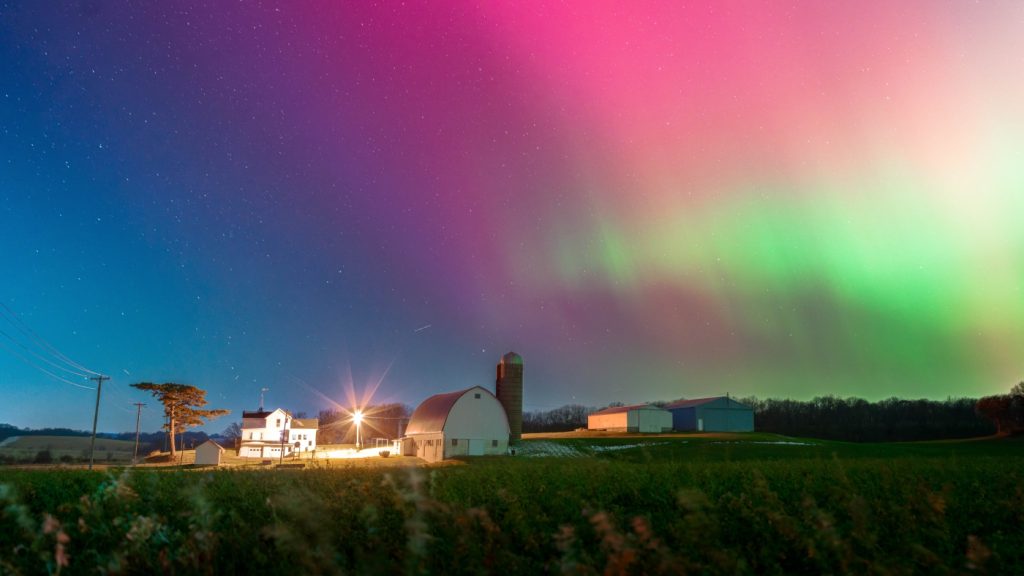The aurora borealis lit up the night sky over Monroe, Wis., on Tuesday night. The northern lights were visible as far south as Alabama and Florida
Ross Harried/NurPhoto via Getty Images
hide caption
toggle caption
Ross Harried/NurPhoto via Getty Images
Geomagnetic storms brought the northern lights to much of the U.S. on Tuesday night, painting the sky in vibrant hues of green and pink.
The Aurora Borealis was spotted in a large swath of states, including Idaho, Iowa, Missouri, New Mexico, New York, Oklahoma, South Dakota, Tennessee, Texas and Washington state. Northern lights were visible as far south as parts of Florida and Alabama, a relatively rare occurrence that highlights the severity of this week’s storms.
“Well, we had activity tonight — a lot of geomagnetic storm activity,” Shawn Dahl, service coordinator at the National Oceanic and Atmospheric Administration’s (NOAA) Space Weather Prediction Center, said in a video on X.
The aurora borealis glows above rural Monroe County, Wisc., as a strong geomagnetic storm from recent solar activity pushes the northern lights unusually far south on Wednesday.
Jeremy Hogan/Getty Images
hide caption
toggle caption
Jeremy Hogan/Getty Images
A geomagnetic storm happens when charged particles from the sun’s atmosphere interact with the Earth’s magnetic field. In addition to creating dazzling displays of color, such storms can disrupt technology on Earth, from satellites and GPS to radio communications and the power grid.
Tuesday’s activity was the result of a phenomenon called coronal mass ejections (CMEs), massive blasts of plasma and magnetic field from the sun’s outer atmosphere that grow in size as they hurtle towards Earth.
Two CMEs arrived on Earth on Tuesday, Dahl said.
The aurora borealis lights up the night sky east of Denver on Tuesday.
Trevor Hughes/USA TODAY Network via Reuters
hide caption
toggle caption
Trevor Hughes/USA TODAY Network via Reuters
The resulting storm reached G4 levels, the second-highest on NOAA’s five-step scale, and created a magnetic field that was “not only eight times stronger than what’s normal but … also favorable for continued activity,” Dahl said in a later update.
Forecasters are awaiting a third and final CME, which they expect will arrive on Earth at midday Wednesday and be even stronger than the previous two.
“That was the most energetic and strongest of this activity out there in space,” Dahl said. “It was traveling significantly faster than these other two, and we think that’s going to pack even a stronger punch than what we’ve already experienced.”
The Space Weather Prediction Center says the aurora may become visible “over much of the northern half of the country, and maybe as far south as Alabama to northern California.”
The Met Office, the U.K.’s national weather service, says the aurora may also be visible over parts of Britain on Wednesday night, though it is likely to be obscured by cloud cover — as was the case in Michigan on Tuesday.
Luckily, Americans in northern states won’t have to wait long for another chance to get a glimpse.
NOAA’s Space Weather Prediction Center “aurora viewline forecast” shows the swath of the northern U.S. in which the northern lights might be visible on Wednesday.
NOAA’s Space Weather Prediction Center
hide caption
toggle caption
NOAA’s Space Weather Prediction Center
How to see (and photograph!) the northern lights
A dark setting is essential to see the aurora, so it’s important to get away from light pollution if you want a good glimpse of the northern lights. It’ll be easiest to see between 10 p.m. and 2 a.m. local time, according to NOAA.
A person watches the northern lights over Hulah Lake in northern Oklahoma on Tuesday.
Andy Dossett/USA TODAY Network via Reuters
hide caption
toggle caption
Andy Dossett/USA TODAY Network via Reuters
It is difficult to predict the exact timing and location of the northern lights, but you can sign up for different services that alert you when an aurora may be visible in your area. For example, a citizen science platform called Aurorasaurus allows users to report when and where they see an aurora, and gives estimates on how visible an aurora is in a given area.
Another option is an app called My Aurora Forecast & Alerts, available for download on both iOS and Android devices. This is a location-based app that gives viewing probability and forecasts.
Smartphone cameras are better at capturing the full array of an aurora than our naked eye, so be sure to go out with your phone to view a fuller spectrum of colors. If your phone camera has a night mode option, it’s best to switch it on when photographing the northern lights. You can also switch your phone camera to manual mode and adjust the exposure settings to get the perfect picture.
The aurora brightens the sky over Putnam Lake in Patterson, N.Y., on Tuesday.
Frank Becerra Jr./USA TODAY Network via Reuters
hide caption
toggle caption
Frank Becerra Jr./USA TODAY Network via Reuters
Why we are seeing more northern lights
Auroras have been happening more frequently in the United States for a while, and will continue to do so for several months. This influx of shimmering colors comes because the sun is reaching the peak of its 11-year cycle and, therefore, its solar maximum. The solar maximum causes solar eruptions, and this increase of activity brings ions, or electrically charged particles, closer to Earth. This stream of particles is known as the solar wind.
As solar winds get closer to Earth, the charged particles collide with gases in the Earth’s atmosphere. When they collide, light is emitted. The light emits at various wavelengths, creating a colorful display throughout the night sky.
When the sun is at its solar maximum, the number of solar eruptions increases, which is why there are more auroras in the sky. Usually, this activity only takes place near the Arctic Circle, but since solar activity is strong right now, viewing areas have expanded to other regions, like the Midwest.


